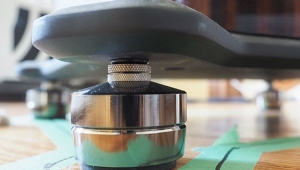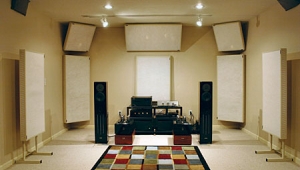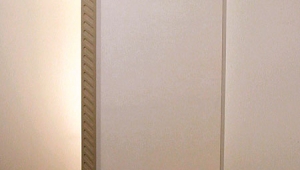| Columns Retired Columns & Blogs |
Nucore Cathedral Sound Room Treatments
One of my favorite Charles Rodrigues cartoons, originally published in Stereo Review and reprinted in the book Total Harmonic Distortion (Perfectbound Press, 1988), shows a customer in the soundroom of an audio dealer, auditioning a pair of speakers. This is no ordinary soundroom: the floor, walls, and ceiling are completely covered with irregularly shaped boxes, apparently an extreme form of acoustical treatment. The salesman is saying, "Of course, you realize that it won't sound exactly the same in your living room, sir..."
I've heard speakers in rooms that had suffered acoustical treatment nearly as extreme. While sometimes the sound was very good indeed, sometimes it was just dull and overdamped. A major practical problem with most room acoustic treatments is that they take up a lot of space, and while some attempt to be "decorator friendly," they're still pretty unsightly. At various times, I've had in my listening room ASC Tube Traps (including a couple of large Bass Traps), Room Tunes, and Room Lenses, but eventually abandoned them all because: a) they created traffic problems ("Watch out for that Room Tune!"), and b) I wasn't convinced that their effects were uniformly positive. The Room Lenses were overall the most effective, but the Avantgarde Uno speakers' large midrange horns made it impossible to place them in such a way that I could open the closet door without having to shove aside some Lenses. The Room Lenses now reside in the attic, along with the Room Tunes, etc. I can't say I miss them.
So when Robert Stein of Ultra Systems called to tell me about an acoustical treatment he said was particularly effective in reducing standing waves but, unlike other acoustical treatment products, was quite small, I had to give it a try.
The Cathedral Sound damping panels (the product literature insists on describing them as "dampening" panels, which makes me think they'll keep the wall moist—perhaps to make the sound more liquid?) measure a mere 11" by 16" by 2" and weigh only 4 lbs. The panels sell for $179.95/pair and are covered in a black or white fabric that can be painted to match the room décor. The panels are to be installed on the wall, near each corner of the room, 6–8" from the ceiling or floor. Two pairs of panels are recommended for most rooms.
For the panels' principle of operation, I refer you to www.ultrasystem.com/usfeaturedPanelsMoreInfo.html.. It has to do with the "Venturi effect" and "acoustic waves that fill the room and stand up in a cosine fashion with wave peaks at the walls and corners." I can't say I completely follow the technical explanation; the important thing is that the Cathedral panels worked. Installed as directed (basically, you drive a supplied special nail into the wall and hang a panel on it), there was a definite improvement in the clarity of the bass, especially apparent with the drums and synthesizer on Mickey Hart's Planet Drum.
Were the improvements of such magnitude that they turned my room into a facsimile of an IEC Listening Room? No. The Cathedral Sound panels weren't magical, but they did make an improvement in the sound of my room. Two things I really like about them is that they're relatively unobtrusive, and no tweaking is involved in their placement—none of that getting the positioning just right or making the sound even worse. Recommended.
- Log in or register to post comments































